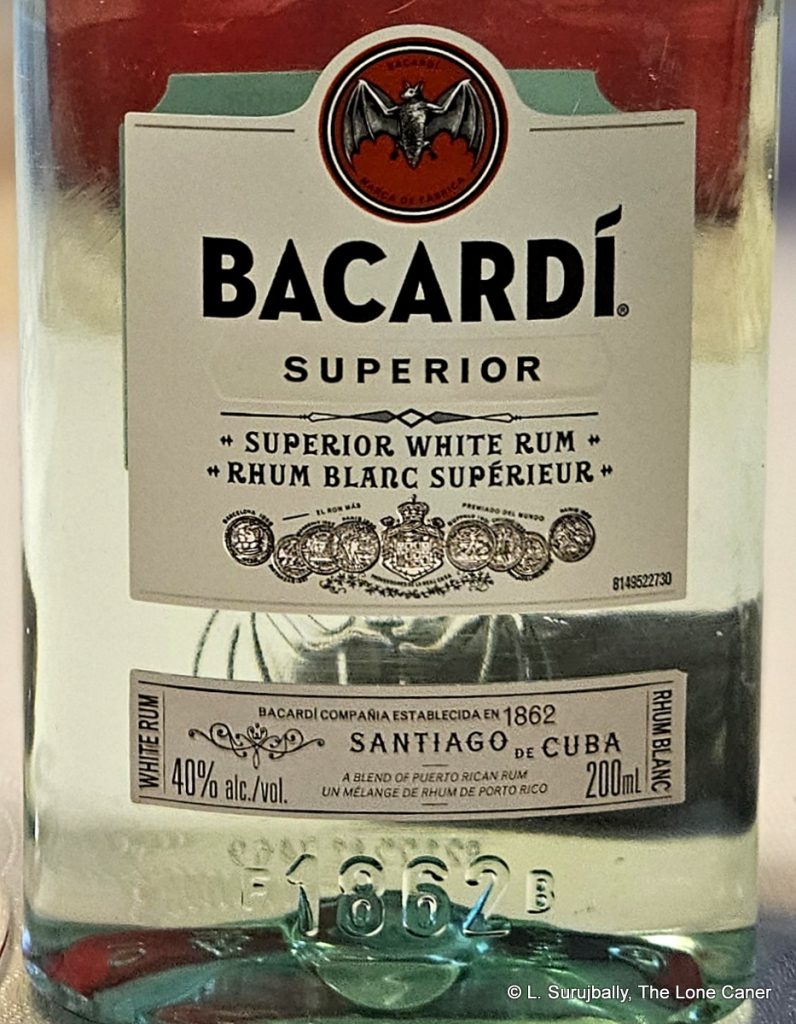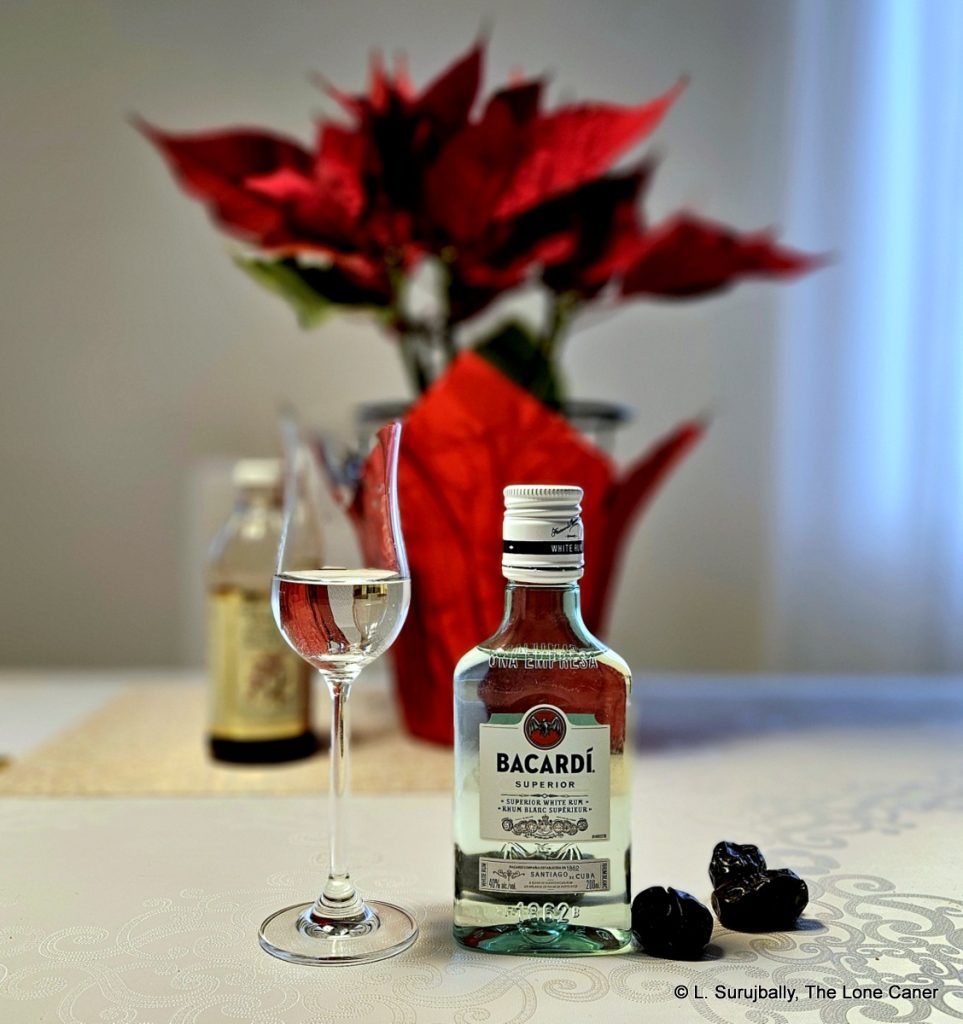Bacardi’s white “Superior” rum is paradoxically both one of the most popular, best selling rums in the world, as well as one of the most sneered at. Any time we extol the magnificence of the unaged Jamaicans, clairins, grogues, agricoles or charandas, it is very likely that the lightly aged, filtered Bacardi product comes in for mention, rarely in any kind of positive light. At best it excites a sort of monumental indifference. Yeah, we drink it but….
The Superior is one of those rums that made the name of Bacardi. At the time of its initial introduction in 1862, rums were made rough and ready, and deserved the name of bathtub moonshine. But by playing with the distillation technology and filtration, Bacardi made a light, smooth, easy rum that was almost completely new. It disappeared into drinks but was easy enough to drink by itself. As the cocktail culture expanded it was a perennial – and recommended – favourite of the mojitos, the daiquiri, the Cuba libre and various others, because it had just enough lightness to not overpower a cocktail, while possessing enough character to be seen as a rum in its own right.
 I can only imagine how poorly made the white rums of the age that created it really were, because by modern standards the Superior is regarded with apathy by most lovers of sipping rums, rather than with any kind of excitement. It remains a column still product from a short-fermented wash, that is lightly aged in American oak barrels, with the base recipe only marginally tweaked in all the years between then and now. I have no records as to how it was made back in the 1800s but now it’s considered to be a blend of a heavier “aguardiente” (pot still rum) and lighter column still high-proof distillate, which is then aged for about a year and then filtered, dialled down to standard strength, and blended for consistency.
I can only imagine how poorly made the white rums of the age that created it really were, because by modern standards the Superior is regarded with apathy by most lovers of sipping rums, rather than with any kind of excitement. It remains a column still product from a short-fermented wash, that is lightly aged in American oak barrels, with the base recipe only marginally tweaked in all the years between then and now. I have no records as to how it was made back in the 1800s but now it’s considered to be a blend of a heavier “aguardiente” (pot still rum) and lighter column still high-proof distillate, which is then aged for about a year and then filtered, dialled down to standard strength, and blended for consistency.
From those rather straightforward, even humble, production processeses comes one of the most well known rums ever made. It is cheap, affordable, a staple of the mixing culture, is a behemoth of the spirits world. It’s been around forever. It sells pretty much everywhere. It is available all over the world. It is mentioned in the literature, in cocktail manuals, and is an entry point to rums for first time drinkers and aspiring mixologists since time out of mind. And it cannot be easily discounted just because of its ubiquity or its cheapness or its light flavour profile.
Speaking for the modern drinker, it’s nothing special. The nose bears this out: very light, very thin, and redolent of rubbing alcohol, acetones, sugar water, cotton candy and vanilla. There’ a barely perceptible touch of almonds and peaches and maybe coconut shavings, but for many, to even get this much is a reach into uncharted waters. Who on earth would take this much time to tease out even those tasting notes? Not many.
And the taste isn’t any better. It’s lightly sweet, has some flowers, re sugar water, more coconut shavings, a touch of citrus zest, more vanilla, an unpleasant whiff of ethanol and not a whole lit else. It concludes i a finish that sums things up nicely: thin, anorexic, inoffensive, with few flavors bleeding over to provide a conclusion that can be admired.
To be sure, the rum has its adherents: one redditor, a few years ago, went against the tide and scored it 8.5, and there is no shortage of people who like it this way just fine. It does the job it was made for – to this day Bacardi makes it clear it’s a mixing rum and nothing else – and few ask for more, especially when a 1.75L bottle costs around fifty (Canadian) dollars in some places. You want a drunk, an alcoholic hit, a base for cocktails? This is the one, for sure.
Based on my experience with rum from around the world and across the quality, age and strength spectrum, nowadays I think of it as a rum lacking sufficient passion, panache or character, and has just enough hooplah to not make it alcoholic sugar water (for which we should give thanks). Others will doubtless have different opinions. But the world has moved on, and we are not in the era of foul rotgut made without standards, where any well-blended halfway decent rum can make a huge impact. From its lauded beginnings where it arguably changed the rumiverse, it has become something of an also-ran, left-behind product; an always available, always affordable rum that’s made to sell and made to mix, but not really made to enjoy, no matter how many glossy ads tell us the opposite.
(#1119)(70/100) ⭐⭐
Other notes

It is the rum equivalent of Johnnie Walker Red whisky.